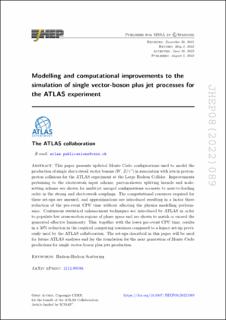Modelling and computational improvements to the simulation of single vector-boson plus jet processes for the ATLAS experiment
Aad, Georges; Abbott, Brad; Abbott, Dale C.; Abed Abud, Adam; Abeling, Kira; Abhayasinghe, Deshan Kavishka; Abidi, Syed Haider; Aboulhorma, Asmaa; Abramowicz, Halina; Abreu, Henso; Ananiev, Viktor; Bjørke, Kristian; Bugge, Magnar Kopangen; Cameron, David Gordon; Catmore, James Richard; Gramstad, Eirik; Heggelund, Andreas; Håland, Even Simonsen; Morisbak, Vanja; Ould-Saada, Farid; Pedersen, Maiken; Read, Alexander Lincoln; Rye, Eli Bæverfjord; Røhne, Ole Myren; Sandaker, Heidi; Vadla, Knut Oddvar Høie; Buanes, Trygve; Djuvsland, Julia Isabell; Eigen, Gerald; Fomin, Nikolai; Huiberts, Simon Kristian; Latour, Bertrand Pascal Christian; Lee, Graham Richard; Lipniacka, Anna; Stugu, Bjarne Sandvik; Træet, Are Sivertsen; Abulaiti, Yiming; Abusleme Hoffman, Angel C.; Acharya, Bobby S.; Achkar, Baida; Adam, Lennart; Adam-Bourdarios, Claire; Adamczyk, Leszek; Adamek, Lukas; Addepalli, Sagar Vidya; Adelman, Jareed; Adigüzel, Aytül; Adorni, Sofia; Adye, Tim; Affolder, Anthony Allen; ATLAS, Collaboration
Journal article, Peer reviewed
Published version

Åpne
Permanent lenke
https://hdl.handle.net/11250/3043772Utgivelsesdato
2022Metadata
Vis full innførselSamlinger
Sammendrag
This paper presents updated Monte Carlo configurations used to model the production of single electroweak vector bosons (W, Z/γ∗) in association with jets in proton-proton collisions for the ATLAS experiment at the Large Hadron Collider. Improvements pertaining to the electroweak input scheme, parton-shower splitting kernels and scale-setting scheme are shown for multi-jet merged configurations accurate to next-to-leading order in the strong and electroweak couplings. The computational resources required for these set-ups are assessed, and approximations are introduced resulting in a factor three reduction of the per-event CPU time without affecting the physics modelling performance. Continuous statistical enhancement techniques are introduced by ATLAS in order to populate low cross-section regions of phase space and are shown to match or exceed the generated effective luminosity. This, together with the lower per-event CPU time, results in a 50% reduction in the required computing resources compared to a legacy set-up previously used by the ATLAS collaboration. The set-ups described in this paper will be used for future ATLAS analyses and lay the foundation for the next generation of Monte Carlo predictions for single vector-boson plus jets production.
